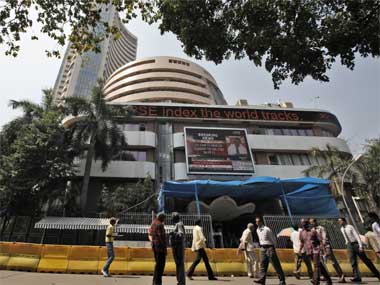Stock Market Today LIVE Updates: Sensex, Nifty breach 3-year lows; telecom, banking stocks in red The Sensex and Nifty touched 3-year lows in late noon. Sensex was at 9,333.51 or 1245.58 points or 4.07 down. Nifty was below 9,000-mark at 8,727.85 points, 239.20points or2.67 percent down. Shares of IndusInd Bank plunged 36 percent to hit a six-year low of Rs 382.55 amid weak market conditions and no relief from Supreme Court to telecom players in the AGR case. The Supreme Court strongly said it would not accept any objections to its orders given earlier with respect adjusted gross revenue (AGR) and all dues will have to be paid as per the order. The Sensex hit a 3-year low at 1 PM at 29,378.38, down 1200.71 points or 3.93 percent. Similarly, the Nifty breached 13 March low of 8,555.15. Both the Sensex and Nifty was in the negative at 11.58 AM. Sensex nosedived 1005.61 points or 3.29 percent to 29,573.48 and the Nifty tanked 311.40 points or 3.47 percent at 8,655.65. Nifty Bank was 6.54 percent or 1448.55 points down at 20,706.60. After opening on a positive note, Sensex was down 293.83 points or 0.96 percent down at 30,285.26 at 9.53 AM. Nifty was 52.30 points or 0.58 percent down at 8,914.75. At 09:17 AM, the Sensex is up 501.46 points or 1.64 percent at 31080.55, and the Nifty up 148.70 points or 1.66% at 9115.75. Yes Bank, Glenmark Pharma, Zee Entertainment, IndusInd Bank, Bharti Infratel, Sun Pharma, Vedanta, Tata Steel, JSW Steel, Titan and UPL are among major gainers on the Indices, while losers are PVR, Kotak Mahindra Bank and Axis Bank. : US stock futures stepped back in choppy early Asian trade on Wednesday as concerns about the widening coronavirus epidemic weighed against hopes policy support would combat its economic fallout. US stock futures ESc1 fell 2.0 percent after the S&P gained 6 percent on Tuesday, paring a little under half of its huge losses on Monday.
#CNBCTV18Market | Dow Futures down nearly 600 points from highs, down 570 points #CoronavirusOutbreak #CoronavirusUSA pic.twitter.com/t3KpfmMTtL
— CNBC-TV18 (@CNBCTV18Live) March 18, 2020
Tuesday’s lift in the S&P 500 came as policymakers around the world cobbled together packages to counter the severe restrictions on various economy-boosting activities aiming at slowing the spread of the virus. “While markets react to positive news on stimulus, that doesn’t last long. I think there are a lot of banks and investors whose balance sheet was badly hit and they will have lots of positions to sell,” said Shin-ichiro Kadota, senior currency and rates strategist at Barclays. The Trump administration on Tuesday unveiled a $1 trillion stimulus package that could deliver $1,000 cheques to Americans within two weeks to buttress an economy hit by coronavirus while many other governments look to fiscal stimulus. “That would be bigger than a $787 billion package the Obama administration came up after the Lehman crisis, so in terms of size it is quite big,” said Masahiro Ichikawa, senior strategist at Sumitomo Mitsui Asset Management. “Yet stock markets will likely remain capped by worries about the spreading coronavirus,” he said. The US Federal Reserve moved on Tuesday to ease funding stress among corporates by reopening its Commercial Paper Funding Facility to underwrite short-term corporate loans. All in all, S&P500 futures are still down more than 9 percent so far this week. In Asia, MSCI’s broadest index of Asia-Pacific shares outside Japan dipped 0.1 percent while Japan’s Nikkei gained 1.9 percent.
#CNBCTV18Market | Asian indices come off highs in early trade; #KOSPI nearly 2% off day's high#CoronavirusOutbreak pic.twitter.com/lldnkTqbcz
— CNBC-TV18 (@CNBCTV18Live) March 18, 2020
Talk of big stimulus is raising some concerns about the long-term outlook of US fiscal health, putting pressure on long-term US government bonds. The spread between 30-year and five-year yields rose to almost 1 percent, the highest since September 2017. The US 30-year bonds yield jumped 38 basis points on Tuesday to 1.648 percent . In the currency market, a shortage of dollar cash supported the US currency. The Australian dollar licked wounds at $0.5990, having hit a 17-year low of $0.5958. The kiwi traded at $0.5946 after hitting an 11-year trough of $0.5919. The dollar held firm against most currencies but dipped 0.25 percent against the safe-haven yen to 107.28 yen. Oil prices sank near their 2016 troughs as the prospects of slow oil demand due to the pandemic added to pressure from a Saudi-instigated price war. US benchmark oil futures CLc1 dropped to as low as $26.61 per barrel, not far off 2016 low of $26.05, a break of which would push them to levels last seen in 2003.


)
)
)

)
)
)
)
)
)
)
)



